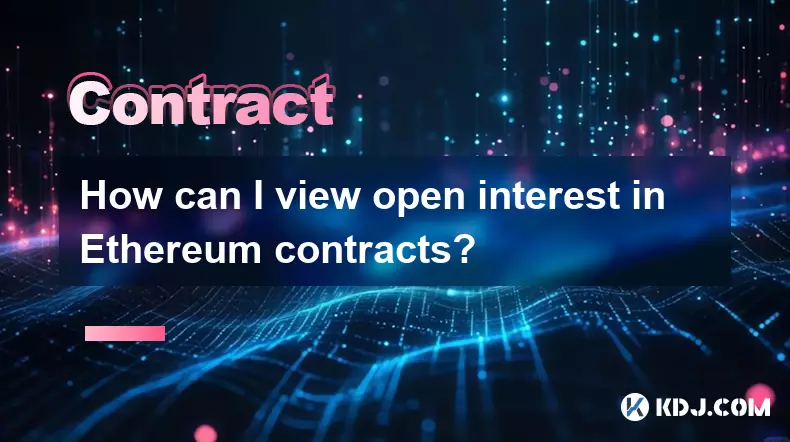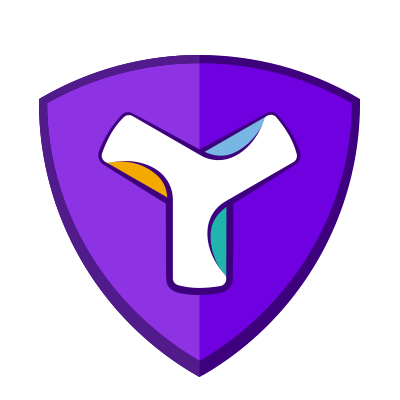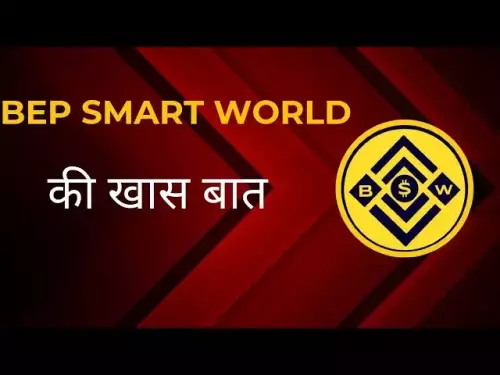-
 bitcoin
bitcoin $112195.049338 USD
2.42% -
 ethereum
ethereum $4124.915858 USD
2.81% -
 tether
tether $1.000570 USD
0.02% -
 xrp
xrp $2.861568 USD
2.25% -
 bnb
bnb $1000.346670 USD
3.04% -
 solana
solana $209.070819 USD
3.38% -
 usd-coin
usd-coin $0.999870 USD
0.02% -
 dogecoin
dogecoin $0.235379 USD
2.65% -
 tron
tron $0.335681 USD
-0.20% -
 cardano
cardano $0.803501 USD
3.38% -
 hyperliquid
hyperliquid $47.120881 USD
3.56% -
 chainlink
chainlink $21.501300 USD
3.44% -
 ethena-usde
ethena-usde $1.000571 USD
0.02% -
 avalanche
avalanche $29.793378 USD
3.62% -
 stellar
stellar $0.366964 USD
2.42%
How can I view open interest in Ethereum contracts?
Rising open interest in Ethereum derivatives signals new capital entering the market, often reflecting growing trader confidence and potential trend strength.
Sep 28, 2025 at 05:18 am

Understanding Open Interest in Ethereum Derivatives
1. Open interest refers to the total number of outstanding derivative contracts, such as futures or options, that have not been settled. In the context of Ethereum, this metric reflects the active positions held by traders across various exchanges. Monitoring open interest helps assess market sentiment and potential price movements.
2. A rising open interest indicates new capital entering the market, often signaling increasing confidence among traders. Conversely, a declining open interest may suggest that participants are closing their positions, possibly due to reduced volatility or anticipation of major shifts.
3. Unlike trading volume, which resets daily, open interest accumulates over time and only changes when new contracts are opened or existing ones are closed. This makes it a more reliable gauge of long-term market engagement.
4. Major cryptocurrency derivatives exchanges like Binance, Bybit, OKX, and Bitget provide real-time data on open interest for Ethereum perpetual and futures contracts. These platforms typically display the information directly on their trading interfaces.
5. Third-party analytics platforms such as Coinglass, CryptoQuant, and Glassnode also aggregate open interest data from multiple sources, offering comprehensive charts and historical comparisons. These tools allow users to analyze trends across different maturities and contract types.
Data Sources for Ethereum Open Interest Tracking
1. Coinglass is one of the most widely used platforms for monitoring open interest in Ethereum and other digital assets. It provides breakdowns by exchange, contract type (perpetual vs. quarterly), and even separates long and short positions.
2. The site features heatmaps showing liquidation levels alongside open interest, helping traders anticipate potential price triggers. Users can filter data by timeframe and view changes in dominance across exchanges.
3. CryptoQuant offers institutional-grade analytics with a focus on on-chain and derivatives metrics. Its Ethereum open interest charts are integrated with funding rates and exchange flows, enabling deeper contextual analysis.
4. Exchange-specific dashboards often include advanced filters, allowing traders to drill down into specific contract series or compare open interest against order book depth. Some platforms also offer API access for automated data retrieval.
5. For developers or quantitative analysts, accessing raw data through official exchange APIs enables custom visualization and integration into algorithmic trading systems. Most top-tier exchanges document these endpoints publicly.
Interpreting Open Interest Movements
1. When open interest increases alongside rising prices, it suggests that new buyers are entering the market, reinforcing the uptrend. This scenario is generally seen as bullish confirmation.
2. If open interest rises while prices fall, it indicates aggressive selling by new short positions, potentially setting the stage for a sharp rebound if those shorts get liquidated.
3. A drop in open interest during a price rally may signal short covering rather than genuine buying pressure, hinting at a weaker trend foundation. Traders watch for divergence between price and open interest to spot such discrepancies.
4. Sudden spikes in open interest can precede periods of high volatility, especially when concentrated around key support or resistance levels. These buildups often attract arbitrageurs and market makers looking to hedge exposure.
5. Regional differences in open interest distribution can reveal shifts in trader bases. For instance, growing open interest on Asia-based exchanges might reflect changing regulatory appetites or capital flows.
Frequently Asked Questions
What is the difference between open interest and trading volume?Open interest counts the total number of active contracts yet to be settled, while trading volume measures the number of contracts traded within a given period. Volume resets daily; open interest does not.
Can open interest be used to predict Ethereum price direction?It cannot predict price directly but serves as a sentiment indicator. Combined with price action and volume, it helps identify whether trends are supported by new positions or unwinding activity.
Why do some platforms show different open interest values for the same contract?Differences arise due to delays in data reporting, variations in calculation methods, or inclusion/exclusion of certain markets. Aggregators may normalize data differently based on their sourcing protocols.
Does open interest include both long and short positions?Yes, each contract has two counterparties—one long and one short—so open interest counts the number of contracts, not individual positions. One contract contributes one unit to open interest regardless of side.
Disclaimer:info@kdj.com
The information provided is not trading advice. kdj.com does not assume any responsibility for any investments made based on the information provided in this article. Cryptocurrencies are highly volatile and it is highly recommended that you invest with caution after thorough research!
If you believe that the content used on this website infringes your copyright, please contact us immediately (info@kdj.com) and we will delete it promptly.
- PM Modi, RSS Centenary, and a Postage Stamp: A Curious Intersection
- 2025-09-29 18:45:12
- Ethereum ETF, Bitcoin ETF, and Investor Nerves: A New York Minute on Crypto
- 2025-09-29 18:25:14
- Ripple, Ondo Finance, and Tokenized Treasuries: A New Era for Institutional DeFi
- 2025-09-29 19:05:13
- Navigating the Crypto Seas: Federal Reserve, Bitcoin, and Interest Rate Tides
- 2025-09-29 18:25:14
- RSS Centenary: A Commemorative Coin and a Century of Impact
- 2025-09-29 18:45:12
- Avantis Crypto Price Crash Amidst Soaring Perpetual Volume: What's Going On?
- 2025-09-29 18:30:01
Related knowledge

How do I use the scheduled order feature in Cardano (ADA) contracts?
Sep 28,2025 at 10:18pm
Understanding Scheduled Orders in Cardano Smart ContractsCardano operates on a proof-of-stakes consensus mechanism and uses the Plutus scripting langu...

How do I enable the "scalping-only" mode for Cardano (ADA) contracts?
Sep 24,2025 at 03:19am
Understanding Scalping Strategies in Crypto Derivatives1. Scalping in cryptocurrency trading refers to executing multiple short-term trades within min...

What is the settlement time for Cardano (ADA) contracts?
Sep 28,2025 at 04:18am
Understanding Cardano's Contract Settlement Mechanism1. Cardano operates on a proof-of-stake consensus model known as Ouroboros, which fundamentally i...

How do I add margin to Cardano (ADA) contracts?
Sep 27,2025 at 07:54pm
Understanding Margin in Cardano (ADA) Smart ContractsCardano operates on a proof-of-stake blockchain that supports smart contracts through its Plutus ...

What is the maximum position limit for Cardano (ADA) contracts?
Sep 23,2025 at 11:00pm
Understanding ADA Futures and Derivatives Market Structure1. Cardano (ADA) futures contracts are offered by several major cryptocurrency derivatives e...

What is the maker fee for Cardano (ADA) contracts?
Sep 26,2025 at 09:01am
Understanding Maker Fees in Cardano (ADA) Contracts1. The concept of maker fees applies broadly across decentralized exchanges and smart contract plat...

How do I use the scheduled order feature in Cardano (ADA) contracts?
Sep 28,2025 at 10:18pm
Understanding Scheduled Orders in Cardano Smart ContractsCardano operates on a proof-of-stakes consensus mechanism and uses the Plutus scripting langu...

How do I enable the "scalping-only" mode for Cardano (ADA) contracts?
Sep 24,2025 at 03:19am
Understanding Scalping Strategies in Crypto Derivatives1. Scalping in cryptocurrency trading refers to executing multiple short-term trades within min...

What is the settlement time for Cardano (ADA) contracts?
Sep 28,2025 at 04:18am
Understanding Cardano's Contract Settlement Mechanism1. Cardano operates on a proof-of-stake consensus model known as Ouroboros, which fundamentally i...

How do I add margin to Cardano (ADA) contracts?
Sep 27,2025 at 07:54pm
Understanding Margin in Cardano (ADA) Smart ContractsCardano operates on a proof-of-stake blockchain that supports smart contracts through its Plutus ...

What is the maximum position limit for Cardano (ADA) contracts?
Sep 23,2025 at 11:00pm
Understanding ADA Futures and Derivatives Market Structure1. Cardano (ADA) futures contracts are offered by several major cryptocurrency derivatives e...

What is the maker fee for Cardano (ADA) contracts?
Sep 26,2025 at 09:01am
Understanding Maker Fees in Cardano (ADA) Contracts1. The concept of maker fees applies broadly across decentralized exchanges and smart contract plat...
See all articles










































































